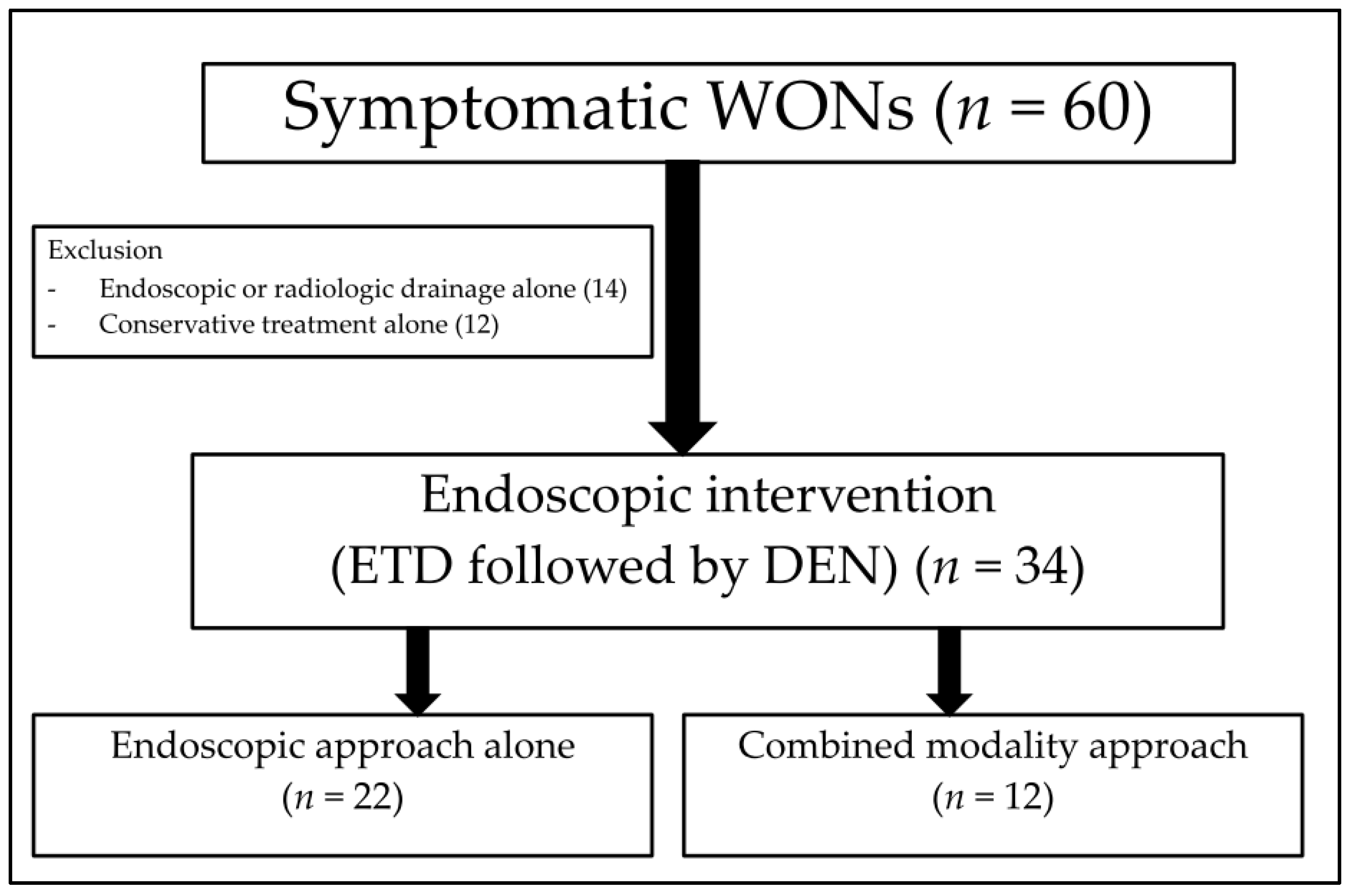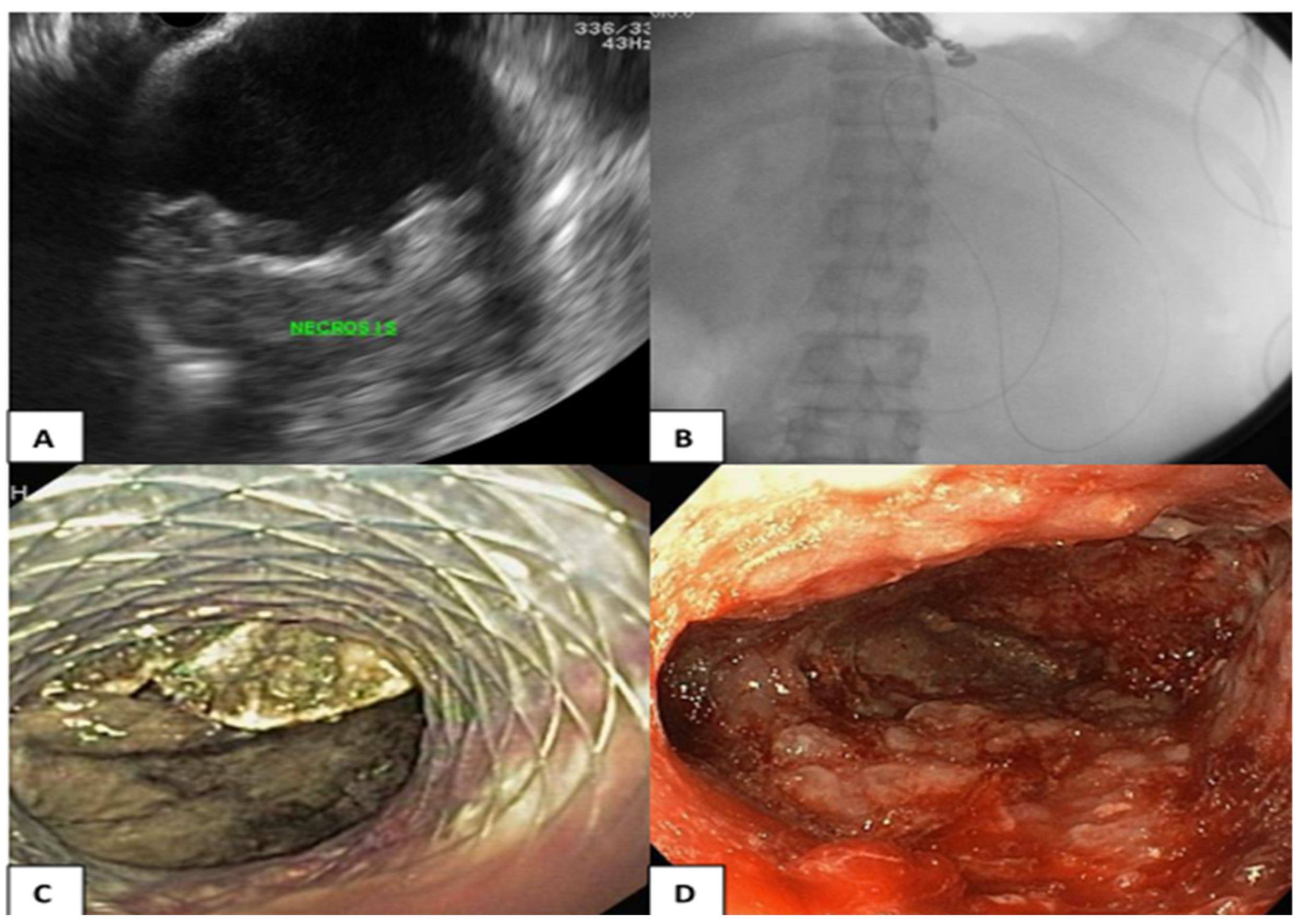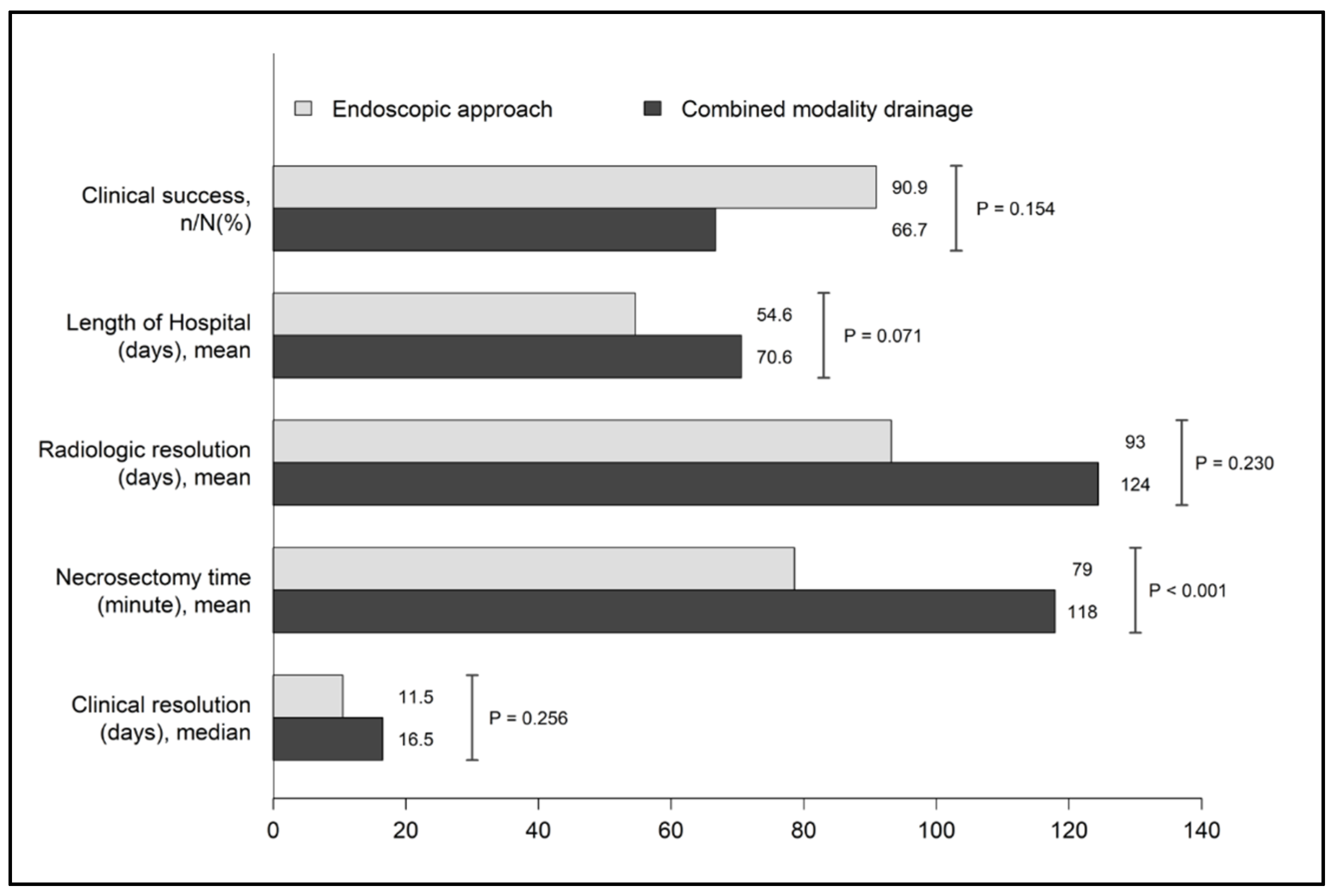Clinical Outcomes of the Endoscopic Step-Up Approach with or without Radiology-Guided Percutaneous Drainage for Symptomatic Walled-Off Pancreatic Necrosis
Abstract
1. Introduction
2. Materials and Methods
2.1. Study Definitions
2.2. Endoscopic Transmural Drainage
2.3. Percutaneous Drainage
2.4. Directed Endoscopic Transmural Necrosectomy
2.5. Data Collection
2.6. Statistical Analysis
3. Results
4. Discussion
Limitations
5. Conclusions
Author Contributions
Funding
Institutional Review Board Statement
Informed Consent Statement
Data Availability Statement
Acknowledgments
Conflicts of Interest
References
- Banks, P.A.; Freeman, M.L. Practice guideline in acute pancreatitis. Am. J. Gastroenterol. 2006, 101, 2379–2400. [Google Scholar] [CrossRef]
- Foster, B.R.; Jensen, K.K.; Bakis, G.; Shaaban, A.M.; Coakley, F.V. Revised Atlanta classification for acute pancreatitis: A pictorial essay. Radiographics 2016, 36, 367–387. [Google Scholar] [CrossRef]
- Banks, P.A.; Bollen, T.L.; Dervenis, C.; Gooszen, H.G.; Johnson, C.D.; Sarr, M.G.; Tsiotos, G.G.; Vege, S.S. Classification of acute pancreatitis—2012: Revision of the Atlanta classification and definitions by international consensus. Gut 2013, 62, 102–111. [Google Scholar] [CrossRef]
- Working Group IAP/APA Acute Pancreatitis Guidelines. IAP/APA evidence-based guidelines for the management of acute pancreatitis. Pancreatology 2013, 13, e1–e15. [Google Scholar] [CrossRef] [PubMed]
- Bang, J.Y.; Arnoletti, J.Y.; Holt, J.P.; Sutton, B.; Hasan, M.K.; Navaneethan, U.; Feranec, N.; Wilcox, C.M.; Tharian, B.; Hawes, R.H.; et al. An endoscopic transluminal approach, compared with minimally invasive surgery, reduces complications and costs for patients with necrotizing pancreatitis. Gastroenterology 2019, 156, 1027–1040.e3. [Google Scholar] [CrossRef] [PubMed]
- Zhang, Y.; Zhang, S.Y.; Gao, S.L.; Liang, Z.Y.; Yu, W.Q.; Liang, T.B. Successful resolution of gastric outlet obstruction caused by pancreatic pseudocyst or walled-off necrosis after acute pancreatitis: The role of percutaneous catheter drainage. Pancreas 2015, 44, 1290–1295. [Google Scholar] [CrossRef]
- Moyer, M.T.; Walsh, L.T.; Manzo, C.E.; Loloi, J.; Burdette, A.; Mathew, A. Percutaneous debridement and washout of walled-off abdominal abscess and necrosis by the use of flexible endoscopy: An attractive clinical option when transluminal approaches are unsafe or not possible. VideoGIE 2019, 4, 389–393. [Google Scholar] [CrossRef]
- Van Brunschot, S.; van Grinsven, J.; van Santvoort, H.C.; Bakker, O.J.; Besselink, M.G.; Boermeester, M.A.; Bollen, T.L.; Bosscha, K.; Bouwense, S.A.; Bruno, M.J.; et al. Endoscopic or surgical step-up approach for infected necrotising pancreatitis: A multicentre randomised trial. Lancet 2018, 391, 51–58. [Google Scholar] [CrossRef] [PubMed]
- Chanrarojanasiri, T.; Ratanachu-Ek, T.; Isayama, H. When should we perform endoscopic drainage and necrosectomy for walled-off necrosis? J. Clin. Med. 2020, 9, 4072. [Google Scholar] [CrossRef]
- Trikudanathan, G.; Tawfik, P.; Amateau, S.K.; Munigala, S.; Arain, M.; Attam, R.; Beilman, G.; Flanagan, S.; Freeman, M.L.; Mallery, S. Early (<4 weeks) versus standard (>4 weeks) endoscopically centered step-up interventions for necrostizing pancreatitis. Am. J. Gastroenterol. 2018, 113, 1550–1558. [Google Scholar] [CrossRef] [PubMed]
- Kumar, N.; Conwell, D.L.; Thompson, C.C. Direct endoscopic necrosectomy versus step-up approach for walled-off pancreatic necrosis; comparison of clinical outcome and health care utilization. Pancreas 2014, 43, 1334–1339. [Google Scholar] [CrossRef] [PubMed]
- Kayal, A.; Taghizadeh, N.; Ishikawa, T.; Gonzalez-Moreno, E.; Bass, S.; Cole, M.J.; Heitman, S.J.; Mohamed, R.; Turbide, C.; Chen, Y.-I.; et al. Endosonography-guided transmural drainage of pancreatic fluid collections: Comparative outcomes by stent type. Surg. Endosc. 2021, 35, 2698–2708. [Google Scholar] [CrossRef]
- Nemato, Y.; Attam, R.; Arain, M.A.; Trikudanathan, G.; Mallery, S.; Beilman, G.J.; Freeman, M.L. Interventions for walled off necrosis using an algorithm based endoscopic step-up approach: Outcomes in a large cohort of patients. Pancreatology 2017, 17, 663–668. [Google Scholar] [CrossRef] [PubMed]
- Van Santvoort, H.C.; Besselink, M.G.; Bakker, O.J.; Hofker, H.S.; Boermeester, M.A.; Dejong, C.H.; van Goor, H.; Schaapherder, A.F.; van Eijck, C.H.; Bollen, T.L.; et al. A step-up approach or open necrosectomy for necrotizing pancreatitis. N. Engl. J. Med. 2010, 362, 1491–1502. [Google Scholar] [CrossRef] [PubMed]
- Gluck, M.; Ross, A.; Irani, S.; Lin, O.; Gan, S.I.; Fotoohi, M.; Hauptmann, E.; Crane, R.; Siegal, J.; Robinson, D.H.; et al. Dual modality drainage for symptomatic walled-off pancreatic necrosis reduces length of hospitalization, radiological procedures, and number of endoscopies compared to standard percutaneous drainage. J. Gastrointest. Surg. 2012, 16, 248–256. [Google Scholar] [CrossRef]
- Gkolfakis, P.; Petrone, M.C.; Tadic, M.; Tziatzios, G.; Karoumpalis, I.; Francesco, S. Efficacy and safety of endoscopic drainage of peripancreatic fluid collections: A retrospective multicentre European study. Ann. Gastroenterol. 2022, 35, 654–662. [Google Scholar] [CrossRef]
- Boxhoorn, L.; Fockens, P.; Besselink, M.G.; Bruno, M.J.; van Hooft, J.E.; Verdonk, R.C.; Voermans, R.P. Endoscopic management of infected necrotizing pancreatitis: An evidence-based approach. Curr. Treat. Options Gastroenterol. 2018, 16, 333–344. [Google Scholar] [CrossRef]
- Lyu, Y.; Li, T.; Wang, B.; Cheng, Y.; Chen, L.; Zhao, S. Comparison between lumen-apposing metal stents and plastic stents in endoscopic ultrasound-guided drainage of pancreatic fluid collection: A meta-analysis and systematic review. Pancreas 2021, 50, 571–578. [Google Scholar] [CrossRef]
- Van Brunschot, S.; Hollemans, R.A.; Bakker, O.J.; Beeseling, M.G.; Baron, T.H.; Beger, H.G.; Boermeester, M.A.; Bollen, T.L.; Bruno, M.J.; Carter, R.; et al. Minimally invasive and endoscopic versus open necrosectomy for necrotizing pancreatitis: A pooled analysis of individual data for 1980 patients. Gut 2017, 67, 697–706. [Google Scholar] [CrossRef]
- Gluck, M.; Ross, A.; Irani, S.; Lin, O.; Hauptmann, E.; Siegal, J.; Fotoohi, M.; Crane, R.; Robinson, D.; Kozarek, R.A. Endoscopic and percutaneous drainage of symptomatic walled-off pancreatic necrosis reduced hospital stay and radiologic resources. Clin. Gastroenterol. Hepatol. 2010, 8, 1083–1088. [Google Scholar] [CrossRef]
- Siddiqui, A.A.; Kowalski, T.E.; Loren, D.E.; Khalid, A.; Soomro, A.; Mazhar, S.M.; Isby, L.; Kahaleh, M.; Karia, K.; Yoo, J.; et al. Fully coverd self-expanding metal stents versus lumen-apposing fully covered self-expanding metal stent versus plastic stents for endoscopic drainage of pancreatic walled-off necrosis: Clinical outcomes and success. Gastrointest. Endosc. 2017, 85, 758–765. [Google Scholar] [CrossRef]
- Gardner, T.B.; Chahal, P.; Papachristou, G.I.; Vege, S.S.; Petersen, B.T.; Gostout, C.J.; Topazian, M.D.; Takahashi, N.; Sarr, M.G.; Baron, T.H. A comparison of direct endoscopic necrosectomy with transmural endoscopic drainage for the treatment of walled-off pancreatic necrosis. Gastrointest. Endosc. 2009, 69, 1085–1094. [Google Scholar] [CrossRef]
- Giovannini, M. Endoscopic ultrasound-guided drainage of pancreatic fluid collections. Gastrointest. Endosc. Clin. N. Am. 2018, 28, 157–169. [Google Scholar] [CrossRef] [PubMed]
- Siddiqui, A.A.; Adler, D.G.; Nieto, J.; Shah, J.N.; Binmoeller, K.F.; Kane, S.; Yan, L.; Laique, S.N.; Kowalski, T.; Loren, D.E.; et al. EUS-guided drainage of peripancreatic fluid collections and necrosis by using a novel lumen-apposing stent: A large retrospective, multicentre U.S. experience. Gastrointest. Endosc. 2016, 83, 699–707. [Google Scholar] [CrossRef] [PubMed]
- Mohan, B.P.; Madhu, D.; Toy, G.; Chandan, S.; Khan, S.R.; Kassab, L.L.; Bilal, M.; Facciorusso, A.; Sandhu, I.; Adler, D.G. Hydrogen peroxide-assisted endoscopic necrosectomy of pancreatic walled-off necrosis: A systematic review and meta-analysis. Gastrointest. Endosc. 2022, 95, 1060–1066.e7. [Google Scholar] [CrossRef] [PubMed]
- Rana, S.S.; Verma, S.; Kang, M.; Gorsi, U.; Sharma, R.; Gupta, R. Comparison of endoscopic versus percutaneous drainage of symptomatic pancreatic necrosis in the early (<4 weeks) phase of illness. Endosc. Ultrasound 2020, 9, 402–409. [Google Scholar] [CrossRef] [PubMed]
- Ge, P.S.; Young, J.Y.; Jirapinyo, P. Comparative study evaluating lumen apposing metal stents versus double pigtail plastic stents for treatment of walled-off necrosis. Pancreas 2020, 49, 236–241. [Google Scholar] [CrossRef]



| Variables | All Cohort (n = 34) | Endoscopic Approach (n = 22) | Combined Modality Drainage (n = 12) | p Value |
|---|---|---|---|---|
| Sex (male), n (%) | 21 (61.8) | 14 (63.6) | 7 (58.3) | 1 |
| Age (year) * | 58.4 ± 12 | 60.6 ± 12.6 | 54.4 ± 10.1 | 0.156 |
| BMI (kg/m2) * | 23.4 ± 4.2 | 24.1 ± 4.2 | 22.1 ± 4 | 0.199 |
| Aetiology of pancreatitis, n (%) | 0.79 | |||
| Gallstones | 19 (55.9) | 13 (59.1) | 6 (50) | |
| Alcohol | 10 (29.4) | 6 (27.3) | 4 (33.3) | |
| Post-ERCP | 4 (11.8) | 2 (9.1) | 2 (16.7) | |
| Others | 1 (2.9) | 1(4.5) | 0 | |
| Severity of pancreatitis * | 0.791 | |||
| (Revised-Atlanta criteria), n (%) | ||||
| Moderately severe | 9 (26.5) | 7 (31.8) | 2 (16.7) | |
| Severe | 25 (73.5) | 15 (68.2) | 10 (83.3) | |
| Multi-organ dysfunction, n (%) | 16 (47) | 9 (40.9) | 7 (58.3) | 0.54 |
| Comorbid disease, n (%) | 23 (67.6) | 15 (68.2) | 8 (66.7) | 1 |
| Hypertension | 19 (55.9) | 13 (59.1) | 6 (50) | 0.882 |
| Diabetes mellitus | 12 (35.3) | 8 (36.4) | 4 (33.3) | 1 |
| Dyslipidemia | 13 (38.2) | 9 (40.9) | 4 (33.3) | 0.727 |
| Ischemic heart disease | 1 (2.9) | 1 (4.5) | 0 | 1 |
| Cerebrovascular disease | 1 (2.9) | 1 (4.5) | 0 | 1 |
| others | 3 (8.7) | 2 (9) | 1 (8.3) | 1 |
| Antiplatelet use, n (%) | 4 (11.8) | 3 (13.6) | 1 (8.3) | 1 |
| Initial eGFR, n (%) | 0.138 | |||
| >60 | 25 (73.5) | 18 (81.8) | 7 (58.3) | |
| 30–60 | 7 (20.6) | 4 (18.20) | 3 (25) | |
| <30 | 2 (5.9) | 0 | 2 (16.7) | |
| Initial total bilirubin † (mg/dL) | 0.8 (0.6–1.5) | 0.8 (0.6–1.4) | 1.1 (0.6–1.8) | 0.601 |
| Initial albumin * (mg%) | 3.5 ± 0.7 | 3.6 ± 0.6 | 3.4 ± 0.8 | 0.594 |
| Initial platelet count (×103) * | 312 ± 98 | 311 ± 100 | 314 ± 103 | 0.925 |
| Initial hematocrit (%) * | 36.5 ± 8.7 | 36.9 ± 7.6 | 35.9 ± 10.9 | 0.766 |
| Initial amylase † (mg/dL) | 1176 (782- 2545) | 1241 (660–2598) | 1089 (862–2105) | 0.514 |
| Initial lipase † (mg/dL) | 2739 (126–5730) | 3787(116–7417) | 1451 (157–3692) | 0.514 |
| Positive hemoculture, n (%) | 2 (5.9) | 1 (4.5) | 1 (8.3) | 0.601 |
| Variables | All Cohort (n = 34) | Endoscopic Approach (n = 22) | Combined Modality Drainage (n = 12) | p Value |
|---|---|---|---|---|
| Severity of pancreatitis by CTSI † | 10 (6.5–10) | 10 (8.5–10) | 9 (6–10) | 0.039 |
| Initial local complication (72 h) | ||||
| APFC | 2 (5.9) | 2 (9.1) | 0 (0) | 0.529 |
| ANC | 31 (91.2) | 19 (86.4) | 12 (100) | 0.537 |
| Encapsulated WON after diagnosis of pancreatitis, (day) † | 30.5 (20–43.8) | 28.5 (20–45) | 32 (22–36) | 1 |
| Symptoms of WON, n (%) | ||||
| Infected WON | 32 (94.1) | 20 (90.9) | 12 (100) | 0.529 |
| Abdominal pain | 17 (50) | 9 (40.9) | 8 (66.7) | 0.282 |
| Gastric outlet obstruction | 2 (5.9) | 1 (4.5) | 1 (8.3) | 1 |
| Intolerable to eat | 1 (2.9) | 1 (4.5) | 0 | 1 |
| Size of WON (CT scan/MRI), (cm) * | 14.6 ± 3.7 | 14.7 ± 3.6 | 14.5 ± 4 | 0.909 |
| Other CT findings of WON, n (%) | ||||
| Vascular thrombosis | 31 (91.2) | 20 (90.9) | 11 (91.7) | 1 |
| Pseudo-aneurysm in WON | 2 (5.9) | 1 (4.5) | 1 (8.3) | 1 |
| Completely walled-off | 21 (61.8) | 12 (54.5) | 9 (75) | 0.292 |
| Wall thickening (mm) † | 3 (3–4) | 4 (3–4) | 3 (3–4) | 0.493 |
| Location, n (%) | ||||
| stomach | 34 (100) | 22 (100) | 12 (100) | 0.086 |
| Rt paracolic gutter collection | 6 (17.6) | 3 (13.6) | 3 (25) | 0.641 |
| Lt paracolic gutter collection | 12 (35.3) | 5 (22.7) | 7 (58.3) | 0.062 |
| Presence of air in WONs | 15 (44.1) | 11 (50) | 4 (33.3) | 0.566 |
| Variables | All Cohort (n = 34) | Endoscopic Approach (n = 22) | Combined Modality Drainage (n = 12) | p Value |
|---|---|---|---|---|
| Duration of first drainage after the diagnosis of AP (day) † | 38 (24.5–71) | 38 (24.5–61) | 42.5 (32–87.2) | 0.773 |
| Duration of first necrosectomy after drainage (day) † | 8 (5–12.5) | 7.5 (5.2–11) | 8 (4.5–14) | 0.828 |
| 0.433 | |||
| 23 (67.7) | 13 (59) | 10 (83.4) | |
| 7 (20.6) | 5 (22.7) | 2 (16.7) | |
| 4 (11.8) | 4 (18.2) | 0 | |
| Stent type, n (%) | 0.317 | |||
| Single plastic stent | 2 (5.9) | 1 (4.5) | 1 (8.1) | |
| Multiple plastic stents | 5 (14.7) | 2 (9.1) | 3 (25) | |
| LAM stents | 27 (79.4) | 19 (86.4) | 8 (66.7) | |
| MTGT, n (%) | 2 (5.9) | 1 (4.5) | 1 (8.3) | 1 |
| 1 | |||
| 8 (23.5) | 5 (22.7) | 3 (25) | |
| Total necrosectomy time, min (SD) * | 92.5 ± 34 | 78.6 ± 27.4 | 118 ± 31 | <0.001 |
| Number of DEN, n (IQR) † | 3.5 (2–5) | 3.5 (2–5) | 3.5 (2.8–5) | 0.839 |
| Necrosectomy technique, n (%) | ||||
| 7 (20.6) | 4 (18.2) | 3 (25) | 0.677 |
| 21 (61.8) | 13 (59.1) | 8 (66.7) | 0.727 |
| Complications of DEN, n (%) | ||||
| Bleeding | 7 (20.6) | 5 (22.7) | 2 (16.7) | 1 |
| Perforation | 1 (2.9) | 0 | 1 (8.3) | 0.353 |
Disclaimer/Publisher’s Note: The statements, opinions and data contained in all publications are solely those of the individual author(s) and contributor(s) and not of MDPI and/or the editor(s). MDPI and/or the editor(s) disclaim responsibility for any injury to people or property resulting from any ideas, methods, instructions or products referred to in the content. |
© 2023 by the authors. Licensee MDPI, Basel, Switzerland. This article is an open access article distributed under the terms and conditions of the Creative Commons Attribution (CC BY) license (https://creativecommons.org/licenses/by/4.0/).
Share and Cite
Pattarapuntakul, T.; Charoenrit, T.; Wong, T.; Netinatsunton, N.; Ovartlarnporn, B.; Yaowmaneerat, T.; Tubtawee, T.; Boonsri, P.; Sripongpun, P. Clinical Outcomes of the Endoscopic Step-Up Approach with or without Radiology-Guided Percutaneous Drainage for Symptomatic Walled-Off Pancreatic Necrosis. Medicina 2023, 59, 569. https://doi.org/10.3390/medicina59030569
Pattarapuntakul T, Charoenrit T, Wong T, Netinatsunton N, Ovartlarnporn B, Yaowmaneerat T, Tubtawee T, Boonsri P, Sripongpun P. Clinical Outcomes of the Endoscopic Step-Up Approach with or without Radiology-Guided Percutaneous Drainage for Symptomatic Walled-Off Pancreatic Necrosis. Medicina. 2023; 59(3):569. https://doi.org/10.3390/medicina59030569
Chicago/Turabian StylePattarapuntakul, Tanawat, Tummarong Charoenrit, Thanawin Wong, Nisa Netinatsunton, Bancha Ovartlarnporn, Thanapon Yaowmaneerat, Teeravut Tubtawee, Pattira Boonsri, and Pimsiri Sripongpun. 2023. "Clinical Outcomes of the Endoscopic Step-Up Approach with or without Radiology-Guided Percutaneous Drainage for Symptomatic Walled-Off Pancreatic Necrosis" Medicina 59, no. 3: 569. https://doi.org/10.3390/medicina59030569
APA StylePattarapuntakul, T., Charoenrit, T., Wong, T., Netinatsunton, N., Ovartlarnporn, B., Yaowmaneerat, T., Tubtawee, T., Boonsri, P., & Sripongpun, P. (2023). Clinical Outcomes of the Endoscopic Step-Up Approach with or without Radiology-Guided Percutaneous Drainage for Symptomatic Walled-Off Pancreatic Necrosis. Medicina, 59(3), 569. https://doi.org/10.3390/medicina59030569






